Nothing excites the imagination like an unanswered question, and since spring I’ve been exploring a little-recognized mystery here in Pennsylvania.
New England has a tradition of dry-laid stone cairns, walls, and chambers that have been variously interpreted over the years as colonial field clearing piles, industrial remains, Celtic structures, Native American memory piles, astronomical observation sites, and sacred places.
We are slowly learning that these structures also exist in parts of Pennsylvania, and this was recently highlighted by a site in Berks County that made me pause and say, “What’s going on here?”
The Oley Hills Site, Berks County
In early March, I spent my last, best pre-COVID site visit in the hills of Berks County at a stone landscape complex known as Oley Hills.
The complex contains numerous constructed stone features such as platforms, cairns (cairn is defined by James and Mary Gage as “an intentionally constructed pile of stones”), curved stone rows, and row-linked boulders built on the top and eastward slope of a broad ridge. Central to this complex is a large boulder that sits perched at the edge of the ridge.
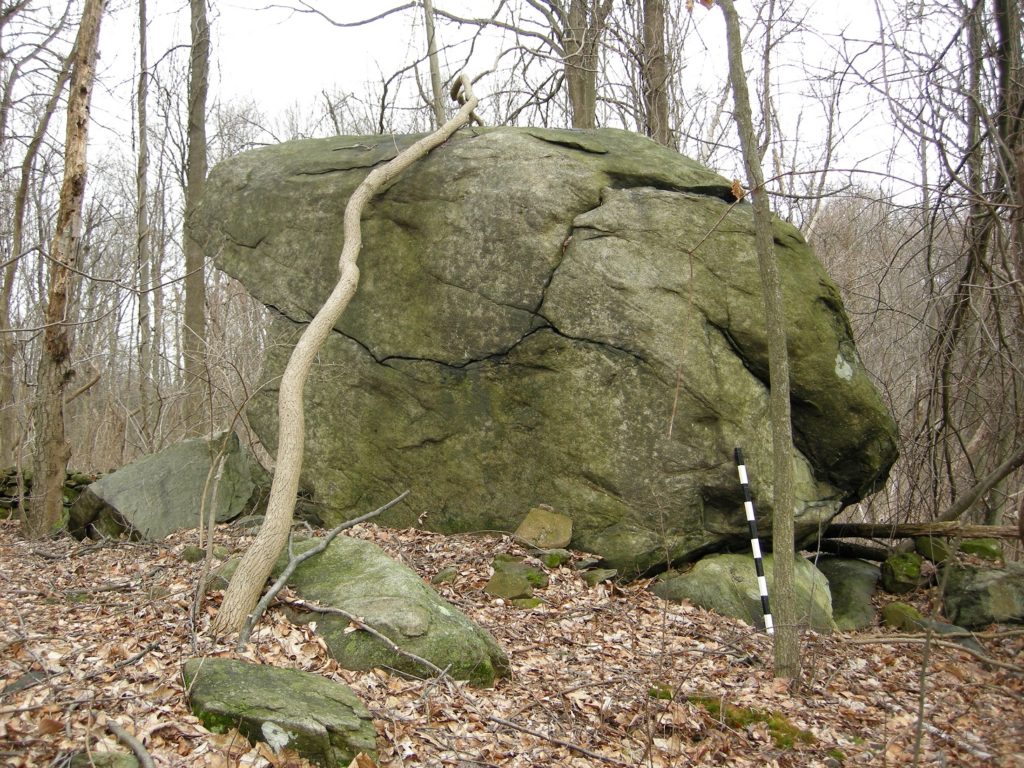
While the traditional archaeological perspective would attribute these constructions to historic-period field clearing practices, these features exhibit a level of careful, labor-intensive, and at times artistic effort that does not readily conform to the idea that they are agricultural in origin.
The site was identified by Fred Werkheiser, a shoe salesman and local historian/avocational archaeologist from Bethlehem. In the late 1990s, Werkheiser shared the site with Norman Muller, an art conservator from Princeton and member of the New England Antiquities Research Association (NEARA) who has investigated and published on numerous stone landscape sites throughout New England.
After consulting with PHMC archaeologists, Muller investigated the Oley Hills site through archival research, geologic assessment, and mapping the site with the assistance of John Waltz, a surveyor and engineer. Their investigations included attempts to date the site’s construction through various analytical methods.
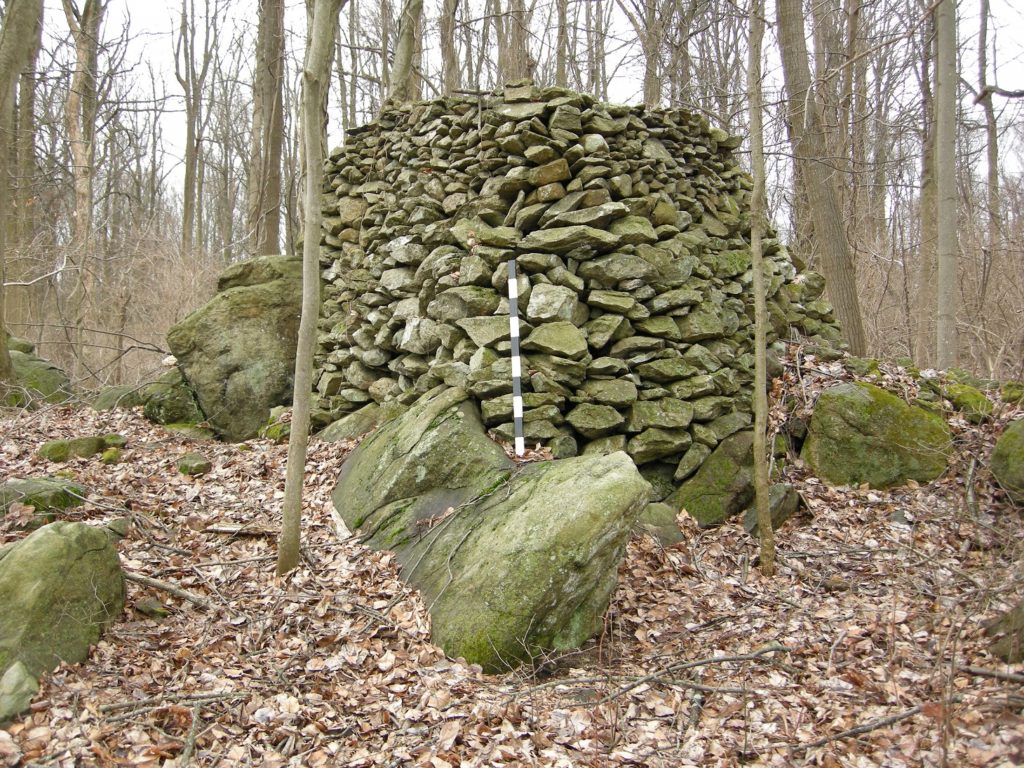
Although the tests conducted so far represent very small samples, they have all yielded results that pre-date European contact. Drawing on site comparisons, historic-period observations of Native American practices, and landscape archaeology theories, the team has interpreted Oley Hills as a possible Native American ceremonial site.
The So-Called “Stone Mound Problem”
The idea that there could be a pre-contact ceremonial stone site – let alone any stone constructions of Native American origin – in eastern Pennsylvania is generally inconsistent with what we have learned from archaeological excavations.
The lack of traditional archaeological evidence (coupled, no doubt, with a reaction against exotic theories claiming that these sites were built by Celts, Vikings, or Phoenicians) has led archaeologists to explain these features in terms of historic-period agricultural practices. There is no doubt that some of these features represent boundary markers, field clearance rows, and the more obvious walls, foundations, and enclosures.
But the issue is not so straightforward, as research groups and stone feature enthusiasts have long questioned the level of effort and care represented by some of these constructions, and instead argue that they represent Native American burials, effigies, ceremonial sites, and astronomical calendars.
An Important Dialogue
In a 2007 resolution, the United South and Eastern Tribes, Inc. (USET) declared that “within the ancestral territories of the USET Tribes there exists sacred ceremonial stone landscapes [CSL] and their stone structures which are of particular cultural value.” The resolution went on to state archaeologists’ interpretation of stone features and landscapes as the result of farming practices has not only left these sacred sites vulnerable to development, but passes judgement on their significance and protection, or lack thereof.
This resolution was shortly followed by the first National Register determination of eligibility for a CSL in Massachusetts in 2008. USET has since collaborated with other agencies and organizations on CSL inventories, survey standards, and training opportunities. Interestingly, a 2016 USET resolution on this topic specifically identified “concentrations of pristine ceremonial stone groupings” in Pennsylvania.
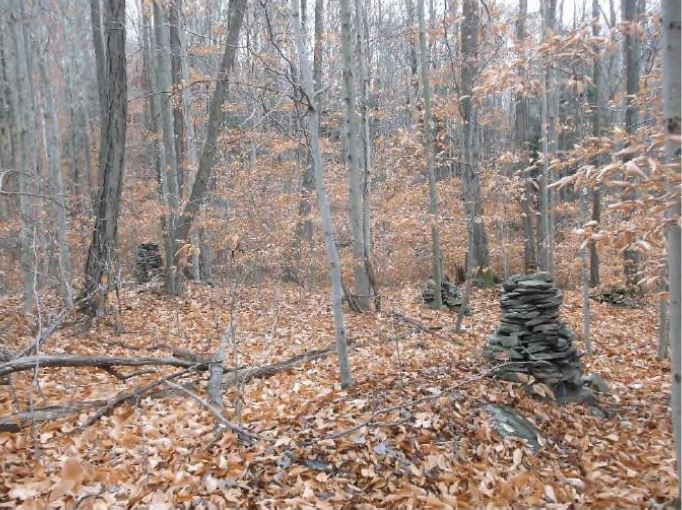
Recent literature relating to stone features recognizes the inherent duality in which both explanations are valid. More importantly, there is an increasing recognition that discourse about memory, patrimony, and cultural identity and marginalization is central to the study of CSLs.
Researchers are sharing respectful methods for documenting and investigating features, ways to distinguish Euro-American historic stone features from those that are Native American in origin, and guidance on evaluation.
The underlying recommendation is that these studies be conducted in consultation with Native American tribes.
Constructed Stone Features in Pennsylvania
While this phenomenon is common in New England, the occurrence of these stone features and landscapes in Pennsylvania is less well known.
Due to the history of conflicting interpretations, when these sites were recorded, they were inconsistently classified as burial mounds, earthworks, and “Other Specialized Aboriginal Sites” – to name a few. Until recently, we did not even have a feature type that could represent these stone stacks of unknown function.
There are 35 recorded sites across Pennsylvania that contain ambiguous stone constructions. The majority of these are cairn clusters ranging in size from a single cairn to fields containing 120 features. Specific information from CRM surveys and NEARA members suggests the potential to record at least 25 additional sites in northeast Pennsylvania alone.
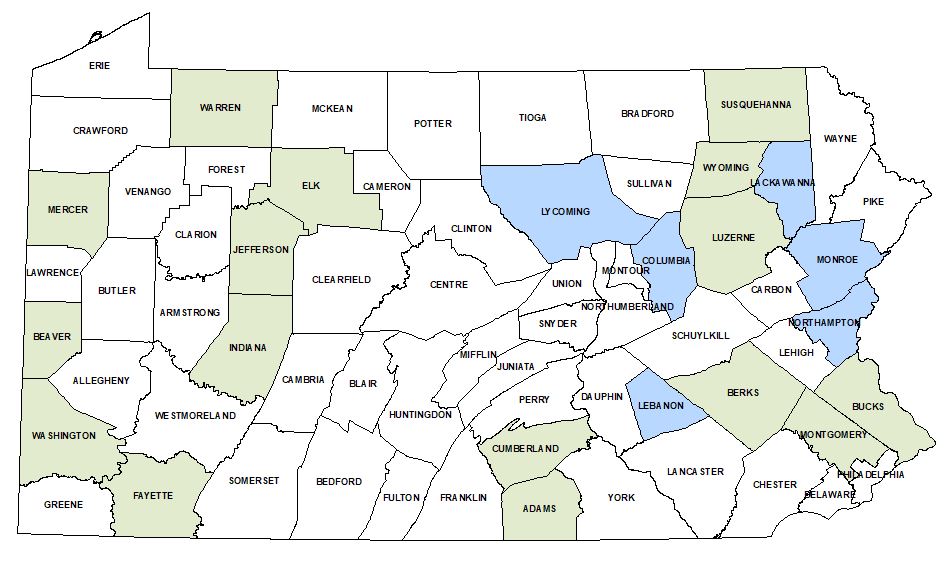
While there are a handful of cairn sites recorded across western PA, we have more recorded sites in eastern PA, as well as feature-level GPS data provided by AECOM from a recent pipeline survey. Regardless, due to the patchy nature of our eastern PA sample, we can only present a few cautious observations.
In our current dataset there appears to be two primary clusters. In the northeast, there is a band of cairns and cairn fields built from the local sandstone of the Devonian Catskill formation. The largest cairn fields known in Pennsylvania are concentrated in this area, and the Pennsylvania CSL identified by USET is located in this region.
In the southeast there is a small cluster of sites that, like Oley Hills, exhibit a greater variety and complexity of feature types, including cairns, platforms, stone circles, possible effigies, and boulders that are connected by stone rows. In addition, some of the features within these complexes appear to exhibit astronomical alignments, and others were constructed in association with visually-striking natural landmarks such as large boulders.
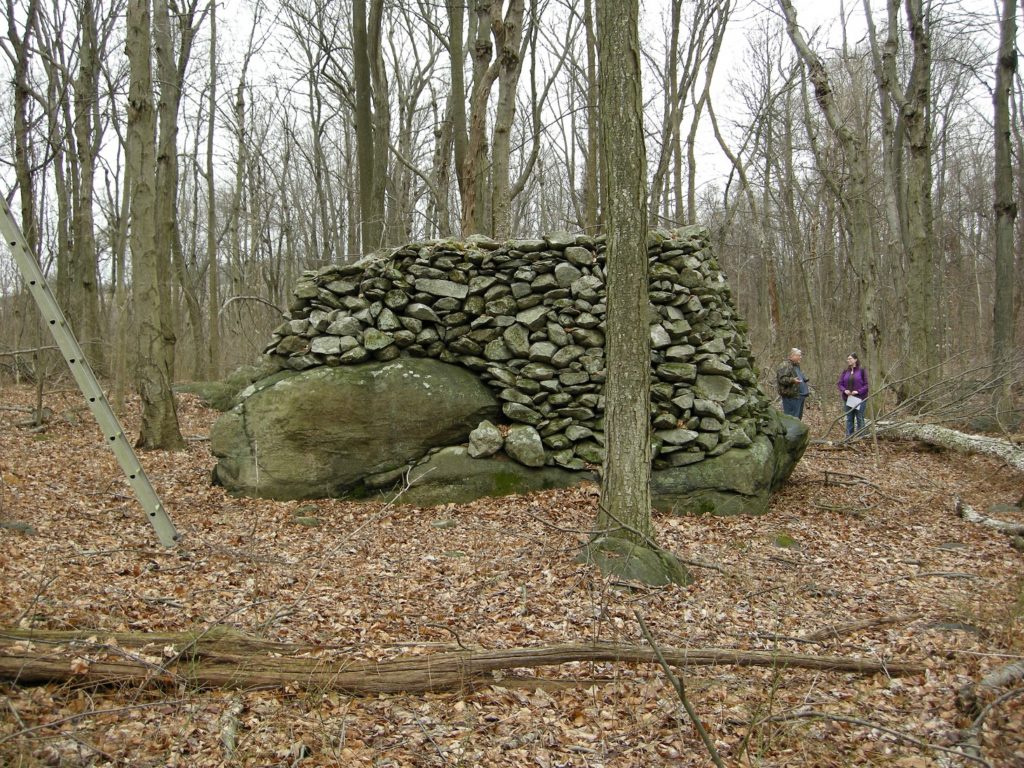
These sites are situated along the Oley and Perkiomen-Lehigh Paths, as identified by Paul Wallace.
Filling in the Gaps
Because the Pennsylvania dataset is so fragmentary at the present time, it is difficult to analyze distribution trends and site characteristics.
After the successful site visit to Oley Hills, we have begun to work with NEARA’s Pennsylvania chapter to encourage recordation of these sites and landscapes. We would welcome more input as we begin to fill these gaps.
A Selection of Recommended Resources
- Gage, James E. and Mary E. Gage, 2005-2020, Stone Structures of Northeastern United States: http://www.stonestructures.org/index.html
- Ives, Timothy H., 2015, Cairnfields in New England’s Forgotten Pastures, Archaeology of Eastern North America, Vol. 43, pp 119-132.
- Moore, Charity M. and Matthew Victor Weiss, 2016, The Continuing “Stone Mound Problem”: Identifying and Interpreting the Ambiguous Rock Piles of the Upper Ohio Valley: https://www.ohioarchaeology.org/journal-of-ohio-archaeology/137-volume-4-2016/504-the-continuing-stone-mound-problem-identifying-and-interpreting-the-ambiguous-rock-piles-of-the-upper-ohio-valley
- Muller, Norman, 2008, Accenting the Landscape: Interpreting the Oley Hills Site: http://rock-piles.com/oleyhill.pdf
- National Center for Preservation Technology and Training, 2017, Ceremonial Stone Landscapes: https://www.ncptt.nps.gov/blog/ceremonial-stone-landscapes/
Comment Policy
PHMC welcomes and encourages topic-related comments on this blog. PHMC reserves the right to remove comments that in PHMC’s discretion do not follow participation guidelines.
Commenters and Comments shall be related to the blog post topic and respectful of others who use this site.
Commenters and Comments shall not: use language that is offensive, inflammatory or provocative (this includes, but is not limited to, using profanity, obscene, or vulgar comments); disparage other commenters or people; condone illegal activity; identify the location of known or suspected archeological sites; post personal information in comments such as addresses, phone numbers, e-mail addresses or other contact details, which may relate to you or other individuals; impersonate or falsely claim to represent a person or an organization; make any commercial endorsement or promotion of any product, service or publication.
If you would like to comment on other topics not related to this blog post but related to PHMC, please fill out the PHMC Contact Us Form.
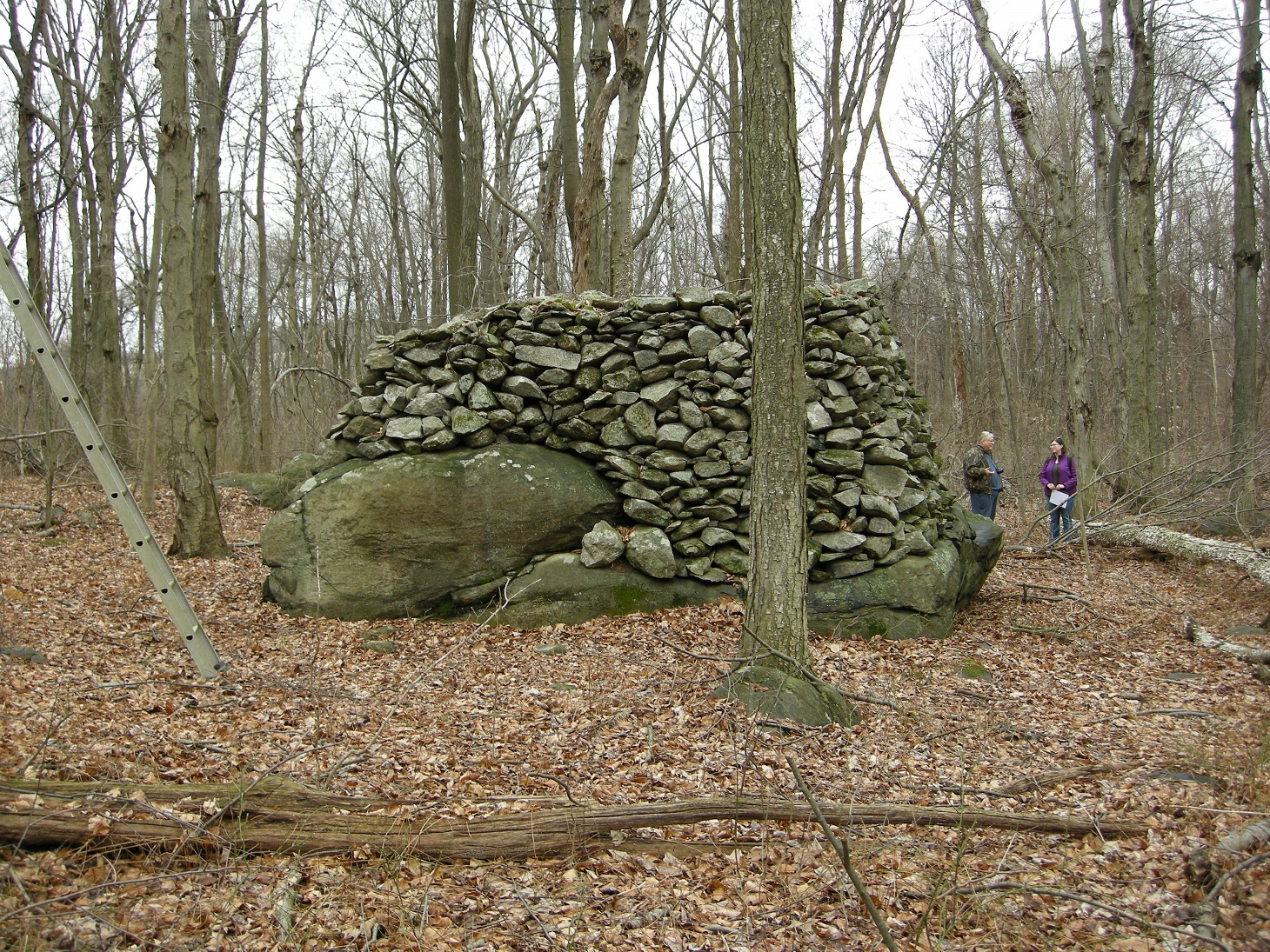
Hi Hannah,
I live in Virginia and we have many of these cairns on our land. I would be interested in talking to you about them.
Hey, Denise! I’m a full-time archaeologist in WV, but working with a colleague to compile information about rock features in Virginia – hopefully for a comprehensive state survey. If you could message https://www.facebook.com/CWVArchaeology/, I will put you in touch with him – since he is local to Virginia.
Are those your photos (mostly)??
Hi Denise,
Check out http://www.neara.org
New England Antiquities Research Association (NEARA) is dedicated to the research of these kinds of stone structures. There are so many stone sites in the northeast and we are always interested in hearing about them outside our area. Send me some pics!
Teresa Bierce
NEARA Membership Chair
membership@neara.org
Would like to talk to our chapter members about this-would you be interested in speaking with our members ? We are digging at the Mouns Jones house in douglassville on wed and sat mornings…this is awesome,never heard of these so close-maybe arrange a walking trip,we are chapter 21/spa members-would like to see this place
Thank you Hannah for a very well written and thoughtful consideration of the potential for significant CSL’s here in Pennsylvania, particularly in the East and Northeast regions. As someone who’s been working in this field of study for over a decade I’m extremely happy to see this level of interest at the PHMC and SHPO. In my opinion these already documented sites and potential sites are an important resource reflecting the true history of our region. While there are plenty of exotic claims, there are also many well recorded features as well as other gems hidden in plain sight. It’s up to the quality of work we field researchers do in concert with open minds such as yours to ensure that these CSL’s are well recorded and taken seriously. So much is here to professionally study and protect.
I thank you for all your help in my own research and recording of the Alpenglow Rockshelter and Council Rock sites. It’s always been my intention that these sites and this entire mountain will be taken seriously and protected accordingly. Just in these past few months we’ve professionally Lidar scanned a quarter mile in length by several hundred meters in width of features. They’re now tied in and registered with one another and georeferenced to within centimeters. So far this work has been to document the known features as well as investigate the potential for others at the site. Much more has already become visible with the trees and vegetation digitally removed. Full analysis is yet to come. GPR surveys conducted of Alpenglow several months ago are still in process. The level and quality of work are forever increasing, largely due to the growing interest of people like yourself.
I thank you again for the serious consideration you give to my own work and that of others. The legacy preserved will largely be due to your open-mindedness and willingness to look with clear, unfettered eyes. My sincere thanks!
I live in Benton pa, Columbia county.
I know of two rock mounds which are located along a stone wall. In the center sits a large boulder and the there is hundreds of smaller rocks around them. I find this stuff so interesting and look forward to hearing more about this.
Great job at summarizing the situation, and I’m thrilled to see something so official acknowledging these structures! Honored to have been included in the recommended reading, as well.
If there is anything I can do through the CRM firm I work for, my role with the Council for West Virginia Archaeology, or as a private volunteer – I would be thrilled!
Great read. We believe we have a cairn site on our property in Southern Ohio. I have diligently studied these cairns up close and online. It’s very intriguing to say the least. I feel like there is still a lot for me to learn about cairn sites. Thank you so very much for the article and the continued ambition to learn more about them.
Great job Hannah! Thanks to your very well written and highly informative post, I think there will be a lot more open-minded discussion going on, especially among professional archaeologists. You hit all the high points–great summary and great start to what we all hope will be a more comprehensive look at these structures.
What an interesting article and fascinating discovery. Thanks for shedding some light on a mysterious cultural landscape.
Interesting information here. I recently discovered some records from ancestors of mine from the 1800s who lived in this area of Berks, and I found one of a marriage taking place in 1813 that had Oley Hills listed as the event place. They were Pennsylvania Dutch, so perhaps it was common for that as well?
There are two curious dry-laid stone structures along Mid State Trail in Charleston Twp, Tioga County, where the footpath uses private land by revocable permission, between Miller Hill Rd and Johnson Hill Rd. They are on a south facing wooded slope near the top, sharply rising on the south face but gentle on north side. They are not quite at a property line or associated with usual field edge stone rows.
There is a large rocky form in berwick, pa, luzerne County, that as a child, we would always climb on. It was nestled in a wooded area, with many small birch trees. I always felt it meant something. It was not far from an area my mother found a large axe while plowing fields. Not anywhere near the rivers that was traveled.. My parents built a home at the top of the mountains,, such a beautiful view between mountains,, that you can see across the susquehanna river clear over to nescopeck. I’ve always loves this place, with large rocks, that just seemed placed there.. Over time, the land was purchased and a home built near. There is a beautiful waterfall nestled downstream. It is such a special place. I’m sure this area has many stories to tell. Approx. 5 miles away, the gas company found a Native American oven on an island they would use to smoke meat. It was investigated, then due to progress was demolished for a new gas line coming across the susquehanna River, between Shickshinny and Berwick.
we have some of these in southeast kentucky we thought
it was indians but they are stacked the same way
This is absolutely wonderful. I have seen stones that were clearly manipulated by someone in my decades of hiking south central PA and always wondered how they were created.
We have quite a few stone ‘ whatevers ‘ here in upper Dauphin county. We gave up trying to report them. Here’s what we get ” Farmers built those “, end of conversation. Ours are on some steep, stone ridden and tree covered hills. There’s simply no way it was possible to farm plus there is a ton of level farm land nearby that’s been farmed for centuries. One cairn is pretty huge and has an oddly even, smooth top. There are ALSO ‘ hollow ‘ piles of rock, top one always massive, a small cave-type thing inside and ( honest ) a few petroglyphs of varying design in some. Also stone tools, quite a few around here.
It’s incredibly frustrating, over 15 years we’ve been dismissed. ” Farmers did that ” and ” Just a rock “.
Hello. My name is Nicholas Koons and I am from Imler Pennsylvania. I’m an avid mushroom hunter all year round. Last year me and my daughter stumbled onto some very interesting things that I now believe to be Native American Cairns. Around the same area, at the peak of a hill, there is what seems to be an ancient fortress. There are 3-4 foot wide paths carved into the rock of the peak. Also around the same area is the remains of a very old but simple log cabin. I see there are no currently known Cairns in Blair county so I would like to know how to proceed. Thank you very much. I would be glad to share my pictures with someone well educated in the manner. Thank you!
Hello from Bath PA. I enjoy all rock structure articles located in my surrounding area.Oley Hills seems very interesting. Thanks for the article.My interest hit a high point while visiting a junkyard (yes a junkyard) on 11/26/20 in Wayne county PA Several stone structures , walls and a foundation (from 19th century farmers) are visible throughout this 123 acre sight located on the southeast side of a hill at the 1200 to 1400 foot elevation less than a mile from the Delaware river and Hancock NY.At least 48 features were GPS mapped by me during my 6 subsequent trips up there.The property owner is very interested in the history of who might have done this as I am.I have researched property deeds in the Honedale PA courthouse, but records only go back to 1830’s. So, if Wayne County PA seems interesting to you for some research, please contact me . Thank you. Mark
Hello Mark. I am local to this, would like to go with you to see these if I could. Thank you. Dave
The map is interesting. Obviously unaware Europeans of the future would define county via lines it seems to make sense say, Dauphin county ( bordered by counties containing both potential and recorded sites ) should also be considered when considering stone structures inside that county as also potentially worthy of study as Native American structures.
I say this because we’re only a crow-fly mile from the Shoop site, apparently considered a camping site occasionally occupied by pre-contact, migratory Native Americans. Our property and several adjacent properties encompassing ridges and tiny valleys have amazing stone structures- not merely cairns ( dismissed as agricultural, we’re disinclined to accept this given they exist in steeply sloped, heavily wooded and never farmed acres ). In the 15 years since we bought our property we’ve discovered knapped tools, dozens of stone tools, at least a dozen petroglyphs, various artifacts carved as profile heads, a few ‘ spirit stones ” ( identified as such by a tribe member we promised not to identify ) and hollow ‘ cairns ‘, possibly burial sites altho some are large enough to be rock shelters.
We’ve attempted numerous times to contact various groups and professionals. I would not be so persistent were it not for the plethora of relics, artifacts and petroglyphs- it seems incredibly important to know who was here, what was their culture and possibly the fact that any culture creating this number of artifacts would probably not be migratory. We have also noticed a distressing number of the type of tools and artifacts we have on our property finding their way onto auction sites, etc. albeit correctly identified ( mostly ) as the product of PA’s first inhabitants. I say ‘ distressing ‘ because as these ancient relics are scattered we’re less and less likely to identify them and their makers.
We’ve also had a decent amount of timbering some of which threatens to destroy at least two spots we’re convinced are rock shelters. We’re very close to the Schuylkill border and not very far from Berks.
We’ve pretty much given up in attempts to have these sites recognized ( if ONE MORE person tells us an amazing artifacts is ‘ just a rock ‘ I’d have popped and flown around the room backwards…. ). Reading this article, I thought we’d have yet another shot at attracting the right interest.
I hope you got some help from these folks. Those of us who are older can pretty much tell if things are farm related. Farmers of all eras have no time to expend energy on these things. Especially if the property was not farmed or the farmed acres were far from the actual cairns. Thus making oh it was just farmers a very lazy inaccurate response.
I have something you might be interested in please send me a send me an email for photos. I know of a property in Lebanon County that has a dry stack Stone megalithic. Huge Multi ton capstones. With a north-south orientation. I am kind of in the middle of inheriting the property. There’s a small creek that runs adjacent to it and has been damaging the mound next to it. I would like help preserving the structure that’s there.
Has anyone replied to your message of May 5, 2022? Although I am unable to visit sites
containing aboriginal stone mounds and walls, I do have contacts in Pennsylvania who could
probably help you. My email address is nemuller5@gmail.com.
Norman Muller
I read quite a few of the comments and it appears that there are a lot of interesting people with sites they are reporting that really need some response and action. I find this all very interesting. Does the Southern tier of NY hold any of these. Am a lover of history!
Connect with the New England Antiquities Research Association. They have a New York State Chapter. And many records of stoneworks through the state.
I’ve been reading about these rock mounds and looking at YouTube videos about them over the past year. I realize most of these mounds are located on private property.
Are there any that can be seen from the road or are located on public land? I drive through an area near Oley, PA when I visit my Uncle in Kutztown. I find would love to be able to see some of these mysterious mounds first hand.